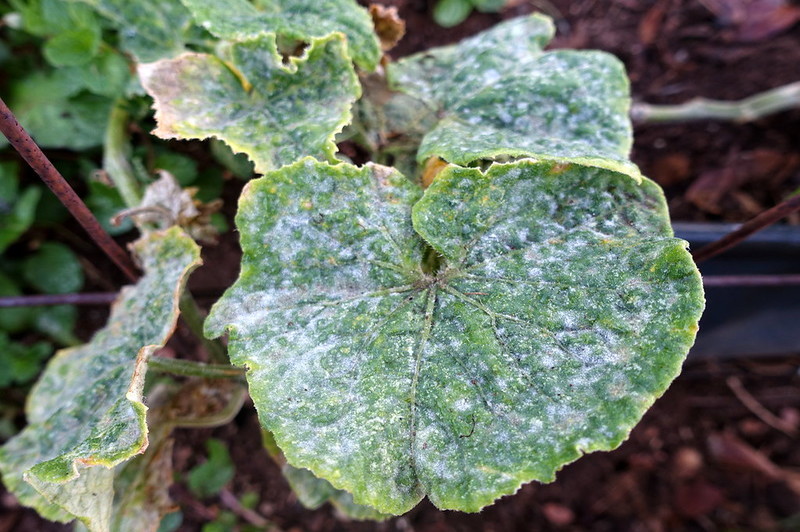Mildew spores have no hosts and just a tiny spectacle of dust flying through the air. However, how long do powdery mildew spores live?
Mildew spores live for 1-16 days without a host but can live longer when it has found a leaf to house and a suitable environment to live in. When it found a suitable habitat, it could only take 2-15 days for it to produce more spores.

Powdery mildew can only live if it has a host and will die if it has none. Except for that powdery mildew that grows on grasses, they are not very susceptible to water and may disperse and eventually die.
What Is Powdery Mildew?
Powdery mildew is a wide known fungal plant disease. Compared to other plant diseases, powdery mildew symptoms are relatively easy to spot.
Different species of fungi cause the growth of powdery mildew, and these fungi are in the order Erysiphales. They usually grow when in a warm and dry environment.
They work by maintaining the moisture of the leaf so that they can propagate and then spread, causing the death of the plant.
Unlike other fungi, powdery mildew does not go off on its own and needs intervention to get rid of it. However, in lid cases of powdery mildew, it will go off on its own.
What Are The Symptoms Of Powdery Mildew?
There are three common symptoms of powdery mildew, and we will tell you all those symptoms that you need to look for to prevent further spread. Fortunately for you, powdery mildew does not affect nearby plants and will only spread at a moderately high humidity level.
If your plant has a flour-like powder on top of its leaves, then most expectantly, powdery mildew is growing on your plant. Your plant will also have yellow to black leaves, and this will only happen if the plant is not adequately taken care of by you.
Lastly, it would be best to look for distorting and bending leaves. Here are more tips on what does powdery mildew look like.
What Plants Do Powdery Mildew Usually Grow On?
Mildew-causing fungal infection only attacks a specific type of plant. Now, we will give you a list of those plants.
First is the cucurbit plants like the zucchini, cucumber, squash, and melon. Another type of plant that it may affect are tomatoes, grapes, and peppers.
Lastly, powdery mildew can also affect flowers, and the flowers in question are zinnias, roses, dahlias, chrysanthemum, and sunflowers.
How Does Powdery Mildew Grow?
The conditions that help the powdery mildew thrive are high relative humidity at night and low humidity during the day with a 22-27C. The spores will be carried by the air currents, germinating on the leaf surface.
The liquid water on the leaf will inhibit the spore germination. The fungi will grow on the leaf surface but will send fine threads into the plant’s cells to obtain nutrients.
It will only take 42 hours from the spore germination to when some new spores form on another leaf or another plant.
How To Prevent Powdery Mildew On Grown Plants
Just like any other pests and disease, preventing it from happening is the best solution you can have. So, here are tips for you on how to avoid powdery mildew growth on plants.
First and foremost, try to plant in a more sunny area since powdery mildew often grows in shady areas. Second, strategically trim your crowded plants so they do not get much humidity.
Lastly, once in a while, try watering from the overhead of the plant to help wash away the spores forming on the leaves.
How To Prevent Powdery Mildew On Germinating Plants
You may think that preventing powdery mildew from growing on your plant will end your trouble, then you may want to think again. Powdery mildew can also infest your seeds.
Here are tips on how to get rid of mold on germinating seeds.
- Provide good air ventilation to your plant.
- Give your plant good light for them to grow well.
- Sterilize your gardening tools before and after you use them.
- Pinch and repot seedlings when they become overcrowded to produce a good airflow.
- Try doing bottom-watering.
Health Risks Of Powdery Mildew
Mildew does not possess any danger unless prolonged exposure to it. The symptoms are cold or flu, but the risk might be greater when you have a history of allergy and asthma.
Unlike mold, mildew has a lighter health risk. The main concern you may experience on powdery mildew is that the plant will have no fruits to harvest.
Powdery mildew on plants may affect the plant’s flowers and potentially never bloom. If it manages to bear a fruit, it may be smaller and inferior to the taste, unlike when it is not damaged.
Conclusion
When you reach this part of the article, you now have an idea on how long do powdery mildew spores live. We hope that this information can guide you well on taking care of your plants.
